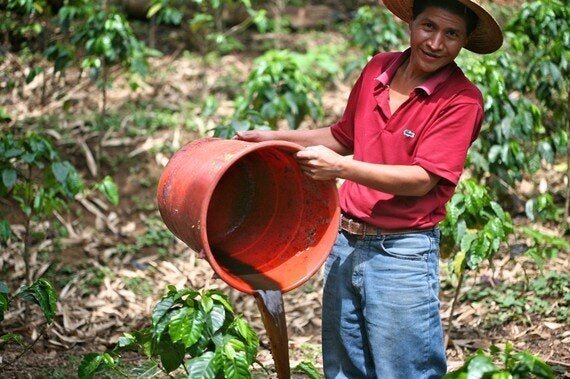
Manuel Guarchaj, President of the Nahualá co-op pours liquor from the compost heap onto a coffee plant. Photo by Sean Hawkey
Any gardener and producer know that worms are good for the soil. Vermicompost is reckoned by serious growers to be the crème de la crème of organic compost. But for coffee farmers in Central America, worms are also an unlikely ally in the fight against climate change.
High in the hills of the Sololá department on Guatemala's volcano-peppered Pacific slope, lie the villages of Pasac and Xejuyup. About 15km from the town of Quetzaltenango in the municipality of Nahualá, the area is home to the Nahualá coffee co-operative. It was here that a group of indigenous coffee farmers came together fifty years ago to try and tackle the extreme poverty prevalent in this remote and mountainous place.
Today, 125 families are members of the Fairtrade certified co-op. Cultivating slopes anywhere between 1,200 and 1,800 meters above sea level the farmers of Nahualá grow Bourbon Arabica trees, which can produce up to 30 per cent more coffee than other varie-ties. The co-op has helped bring economic stability and development to the community.
"A good harvest has huge significance for the family economy," says co-op manager Juan Choc. "All our activities depend on it."
But climate change is an increasing challenge for the co-op. In 2012, disaster struck when a major epidemic of coffee rust disease broke out across Latin America and the Caribbean resulting in huge losses to the coffee crop. In early 2013 Guatemala declared a state of agricultural emergency. Almost three-quarters of the country's coffee crop had been blighted by the fungus.
Coffee rust - or Hemileia vastatrix - first appeared in east Africa around 150 years ago, but global warming caused by climate change mean it is now a world-wide problem, especially for Arabica coffee which makes up 70% of global production. Arabica coffee farmers are all too familiar with the cycle of devastation: the plant's shiny green leaves turn brown, before the fungus spreads to the berries, changing them from bright red to a dull grey. The bushes can be treated with chemicals but it can take years for a plant to recover.
The good news is that coffee rust can't survive in temperatures below 10 degrees celsius. That's why coffee farms tend to go higher up the mountains where cooler, drier weather keeps the disease in check. But the smallest changes in temperature, rainfall and humidity can wreak havoc to crops. Coffee rust causes the trees to lose their leaves and produce fewer beans of inferior quality. It's an annual hazard in this part of the world, posing an ongoing threat to the farming family economy. And there is a crucial link between disease, climate change and poor quality soil.
That's where the worms come in. "We use the pulp or peel from the coffee beans," says Juan. "When that's not available, we use weeds and organic kitchen waste to feed the worms. Farmers will load a sack with fifty kilos of organic manure and carry it on their backs to the fields. This is a big job for the community," he says, "but we want to recover what was lost and leave a good legacy for our children."
Worms can chomp through their entire body weight in a day. By feeding them food scraps or decaying organic material, such as leaves or coffee bean pulp, they give you back much more in terms of plant nutrients and micro-organisms to reinvest in the soil.
As well as the main ingredients needed by plants - nitrogen, potassium and phosphorus - worm compost also contains lots of trace elements, such as calcium and manganese. Think of all these as equivalent to the vitamins needed by humans.
In addition, the resulting vermicompost, which contains lots of humic acid, also improves the condition and structure of the soil. The result: nutrient-rich, good quality soil that can breathe, hold water and drains well means that the plants grown in it will be strong, healthy and productive - and better able to resist the dreaded coffee rust.
"We are right on the slopes of the Santo Tomas volcano," says Juan. "The soil is vulnerable both to erosion and drought. Our grandparents tell us that fifty years ago the land here was very fertile. They were able to gather great harvests because of it. But, now, the yield is no longer as good as it used to be."
Replenishing the soil in the coffee plantations with worm compost is not the farmers' only weapon in the fight against climate change. They've carried out reforesting projects so their coffee trees can grow beneath a lush natural canopy, and they've diversified into other crops such as bananas and maxán (the leaves make great wrappers for tamales!) which are better adapted to changing local conditions. Planting beans helps fix nitrogen into the soil.
Juan and his fellow farmers are realistic about the future. Worms alone won't solve climate change, but they can play their part. "When the plants don't have access to nutrients in the soil, they become like malnourished children," he explains. "But when the plants can get what they need and are healthy, they can resist the coffee rust disease."
Fairtrade producers have been at COP21 in Paris, making the voice of smallholder farmers heard in the debate. Learn more about Fairtrade's work with farmers to tackle climate change at www.fairtrade.net/climate-change, or view short films of Fairtrade climate heroes here.
This piece first appeared in Spanish on PlanetaFuturo/ElPaís on December 9, 2015 and is reproduced with their kind permission.
